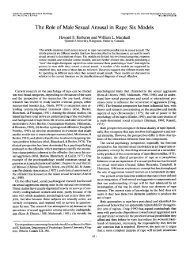Regulation of the dopamine transporter - Addiction Research ...
Regulation of the dopamine transporter - Addiction Research ...
Regulation of the dopamine transporter - Addiction Research ...
You also want an ePaper? Increase the reach of your titles
YUMPU automatically turns print PDFs into web optimized ePapers that Google loves.
Schmitt & Reith DAT <strong>Regulation</strong><br />
Figure 2. Metabolic reaction pathway <strong>of</strong> MDA-like compounds leading to <strong>the</strong> formation <strong>of</strong> neurotoxic prooxidant<br />
thioe<strong>the</strong>r species and <strong>the</strong> relative toxicity <strong>of</strong> metabolites. The parent compounds MDA and MDMA are not directly<br />
cytotoxic. 131,132 However, demethylenation <strong>of</strong> <strong>the</strong> 3,4-methylenedioxy moiety by <strong>the</strong> hepatic CYP2D6 enzyme 135<br />
results in <strong>the</strong> formation <strong>of</strong> 3,4-dihydroxyamphetamines, which are readily oxidized to quinones. 134 These quinones<br />
can form conjugates with GSH, greatly potentiating neurotoxicity. 138 Fur<strong>the</strong>r metabolism in <strong>the</strong> brain via <strong>the</strong><br />
mercapturic acid pathway results in toxic NAC-conjugated species. Although <strong>the</strong> quinones, GSH-conjugates, and<br />
NAC-conjugates all promote <strong>the</strong> formation <strong>of</strong> reactive oxygen species, NAC-substituted compounds appear to possess<br />
<strong>the</strong> greatest relativistic potential for toxicity owing to <strong>the</strong>ir protracted rate <strong>of</strong> elimination from <strong>the</strong> brain. 137 (In color<br />
in Annals online.)<br />
in vivo. 136,137 Quinones are strong electrophiles:<br />
<strong>the</strong>y can serve to propagate ROS via a one-electron<br />
redox reaction to a stable semiquinone radical<br />
or form conjugates with reducing agents via<br />
two-electron nucleophilic attack. 138 In particular,<br />
<strong>the</strong> dopaminoquinone-like metabolite <strong>of</strong><br />
MDA/MDMA can undergo conjugation with<br />
<strong>the</strong> cysteinyl thiol moiety <strong>of</strong> <strong>the</strong> endogenous<br />
reductant glutathione (GSH) to form <strong>the</strong> thioe<strong>the</strong>r<br />
5-(glutathionyl)-�-methyl<strong>dopamine</strong> (5-(GSH)-<br />
�MeDA) or its N-methyl analogue. 136 In <strong>the</strong> central<br />
nervous system, <strong>the</strong> 5-(glutathionyl)-thioe<strong>the</strong>rs<br />
are ultimately metabolized via <strong>the</strong> mercapturic<br />
acid pathway to form 5-(N-acetyl-cysteinyl)-<br />
�-methyl<strong>dopamine</strong> (5-(NAC)-�MeDA) and its<br />
N-methyl analogue (5-(NAC)-�,N-diMeDA).<br />
The structural formulae <strong>of</strong> <strong>the</strong>se metabolites<br />
and <strong>the</strong>ir relative potencies as neurotoxins are<br />
displayed in Figure 2. The thioe<strong>the</strong>r metabolites are<br />
potent serotonergic neurotoxins that can induce<br />
a dose-dependent increase in ROS formation and<br />
cause caspase-3–mediated apoptosis in cultured<br />
cortical neurons. 137 Moreover, direct intrastriatal<br />
administration <strong>of</strong> pure 5-(NAC)-�,N-diMeDA in<br />
rats fully recapitulates <strong>the</strong> serotonergic toxicity<br />
observed with systemic high-dose MDMA. 136<br />
These thioe<strong>the</strong>rs are detectable in <strong>the</strong> rat brain<br />
after systemic administration <strong>of</strong> a high-dose<br />
neurotoxic regimen <strong>of</strong> MDMA—repeated dosing<br />
leads to significant accumulation due to a<br />
nonlinear increase in elimination half-life. 139<br />
Interestingly, cotreatment with <strong>the</strong> antioxidant<br />
GSH precursor N-acetylcysteine (NAC) successfully<br />
protects cultured cortical neurons from<br />
thioe<strong>the</strong>r-induced apoptosis and attenuates <strong>the</strong><br />
formation <strong>of</strong> ROS, even though NAC could<br />
Ann. N.Y. Acad. Sci. 1187 (2010) 316–340 c○ 2010 New York Academy <strong>of</strong> Sciences. 331










